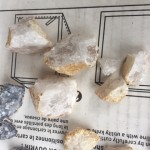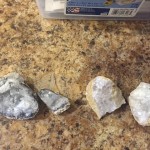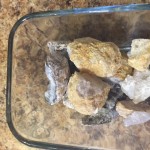Our most recent activity to try was to break geodes… My youngest and I found a kit and decided to give it a try. Our kit came with two geode rocks and a hammer. For safety we found a pair of goggles to use to protect our eyes and went out to the driveway.
The instructions with the kit said to gently tap the geode with the hammer and the geode would break – not too hard or it would shatter. Interestingly enough ours seemed to be a tough rock! We finally had to resort to getting my husband. The first geode broke after some harder hits. Breaking into several pieces and scattering, but it was obviously a geode.
Our second wasn’t as easy, after trying to tap it fairly hard with a hammer we moved on to the flat side of an ax. – Safety equipment was taken into account, and I should say if you try this yourself, make sure you have goggles and skin covered. The geode finally broke and we found this one was 95% solid inside. That did explain why it was so difficult to break.
After breaking open our geode we had to venture online to find out how geodes are formed:
Geodes can form in any cavity, but usually means fairly rounded formations in igneous and sedimentary rocks. They can form in gas bubbles in igneous rocks, such as vesicles in basaltic lavas; or, as in the American Midwest, in rounded cavities in sedimentary formations. After rock around the cavity hardens, dissolved silicates and/or carbonates are deposited on the inside surface. Over time, this slow feed of mineral constituents from groundwater or hydrothermal solutions allows crystals to form inside the hollow chamber.
I’m not sure if we will save our geodes and do something with them or not. I’ve seen bookends make from geodes before, but ours are smaller pieces of rock, maybe I can attach our geodes to keychains.






 I am a SAHM/WAHM of three boys ranging in age from 13 to 29. We are working on saving enough for college at the same time as dealing with school and our older independent kids. I author a few blogs, including http://teched4kids.com. I have in the past taught computer information technology classes for the local university and taught workshops for kid's in technology education besides being the Kentucky State FIRST LEGO League Championship Coordinator from 2005 to 2008. I now work as a computer consultant, run a handmade home business, and am available for workshops. Life here is always an adventure!
I am a SAHM/WAHM of three boys ranging in age from 13 to 29. We are working on saving enough for college at the same time as dealing with school and our older independent kids. I author a few blogs, including http://teched4kids.com. I have in the past taught computer information technology classes for the local university and taught workshops for kid's in technology education besides being the Kentucky State FIRST LEGO League Championship Coordinator from 2005 to 2008. I now work as a computer consultant, run a handmade home business, and am available for workshops. Life here is always an adventure!
